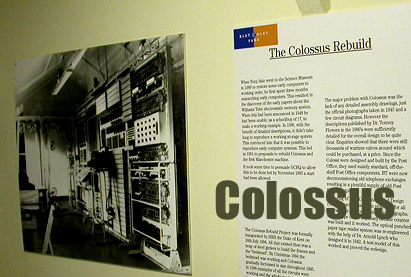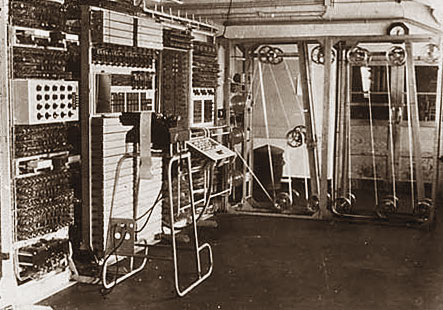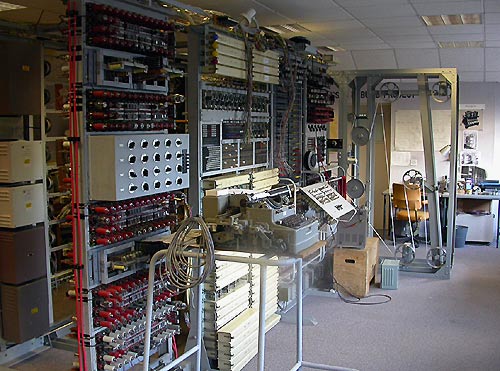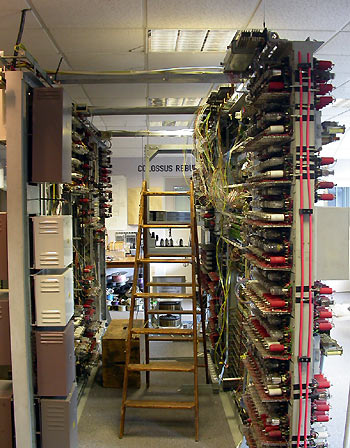
THE HIGH COMMAND of the German Army, having
decided that a very high security device was
required to enable it to communicate by radio,
approached the Lorenz company to design and
produce a suitable teleprinter machine. A method
for enciphering teleprinter messages was invented
by the American, Gilbert Vernam, in 1918 and
employed a 32-symbol Baudot code which comprised
five channels, each of which contained a stream
of bits represented as ‘no-hole’ or
‘hole’, ‘0’ or
‘1’, and ‘dot or
‘cross’. A message was encoded by
combining the original with a sequence of
obscuring characters using modulo 2 addition
(exclusive NOR in boolean terms). At the
receiving end the message was decoded by once
again adding the same sequence of obscuring
characters. (Incidentally, the Enigma machine
used the normal 26-letter alphabet and Morse
code.)
|

The Lorenz machine was multi rotor machine, a
great advance on the Enigma three and four rotor
machines. Teleprinter signals transmitted by the
Germans using a Lorenz machine were first heard
by the British in early 1940. At Bletchley Park a
section, headed by Major Ralph Tester, was set up
in B Block at Bletchley Park to examine Lorenz
encoded messages. The section later moved to F
Block which had been built close to Hut 11 in
early 1943 (but has, since the war, been
demolished). The Lorenz messages were given the
general classification, ‘Fish’, and
individual codes were provided with such names as
‘Tunny’ and ‘Jellyfish’.
|
|
Brigadier John Tiltman, who was working in what
had then become known as 'The Testery, knew of
the Vernam system and was able to identify
messages that had been encoded using this method.
Tiltman and Bill Tutte exploited a number of
errors made by German radio operators and began
to work out how the Lorenz encoding machine
functioned. Eventually this led to the successful
decoding of Lorenz messages.
One of the problems, however, was
the inordinate time taken to work out the correct
settings; by the time the message was decoded the
information was useless. Max Newman, a
mathematician working at Bletchley, believed that
it would be possible to automate some parts of
the process for finding the settings. This would
involve using two loops of paper tape, the first
containing the original message to be decoded and
the second containing a repeating pseudo random
sequence. Each possible setting was to be tested
and, hopefully, the machine would eventually
produce the correct one.
|
|
A suitable machine, known as ‘Heath
Robinson’, after the quirky
cartoonist/designer, and also as a ‘Tunny
Rack’, was designed at Newman’s
request by TRE in Malvern and built by the Post
Office Research Laboratories at Dollis Hill,
London. ‘Heath Robinson’ was
delivered to Bletchley Park and installed in Hut
11 which had earlier held the original Turing
Bombes.
Robinson consisted of three parts,
the frame on which the two teleprinter paper
tapes were mounted and read optically, known as
the Bedstead, a rack containing the counters,
another rack the valved logic circuits and a
plug-jack panel. for plugging up the algorithms.
The short counters rack was produced at TRE and
the Bedstead and valve rack at the GPO research
labs at Dollis Hill.
|

However, although Robinson provided results it
also proved to be unreliable because of the
difficulties arising in synchronising the two
tapes in the mechanical tape reader.
Tommy Flowers, an electronics
engineer at the Post Office Research
Laboratories, managed to dispense with the paper
tapes, replicating them electronically by using a
large number of valves (vacuum tubes). Modified
digital switching, using valves instead of
mechanical relays, also increased the overall
speed of the unit which was given the
name,‘Colossus’.
A picture of the tenth and
last Colossus machine to be installed at
Bletchley Park. (left)
|

Work on Colossus had begun in March 1943; in
January 1944 the first unit was delivered to
Bletchley Park. Combined with the
‘Tunny’ frame, Colossus was able to
decode the Lorenz messages within hours. (N.B.
Colossus was not used to decode the Enigma
ciphers.) An improved version, Mark 2, was put
into service in June 1944 in time to assist the
Normandy campaign. By the end of the war a total
of ten machines had been installed at Bletchley
Park, five in the annexe of the now demolished F
Block and five in H Block which is now the site
of the current Colossus rebuild (and also houses
most of the exhibits shown in this website).
After the war eight of the machines were
dismantled. The other two were removed to
Easthope. It should be realised that, in spite of
many statements to the contrary, Alan Turing did
not design Colossus. Its mechanism, however, did
rely upon the theories that Turing had used to
solve the German Naval Enigma codes. And Turing's
subsequent understanding that Colossus had
functioned correctly confirmed his resolve to go
ahead with his ideas for a more advanced
computer.
|

In the mid-1990's plans were put into place to
rebuild a working replica of Colossus. On 6 June
1996 the Duke of Kent formally switched on the
rebuild that had taken over two years to
complete.
The rebuilt Colossus now on show at Bletchley
Park. (left and above)
|

|

|
|